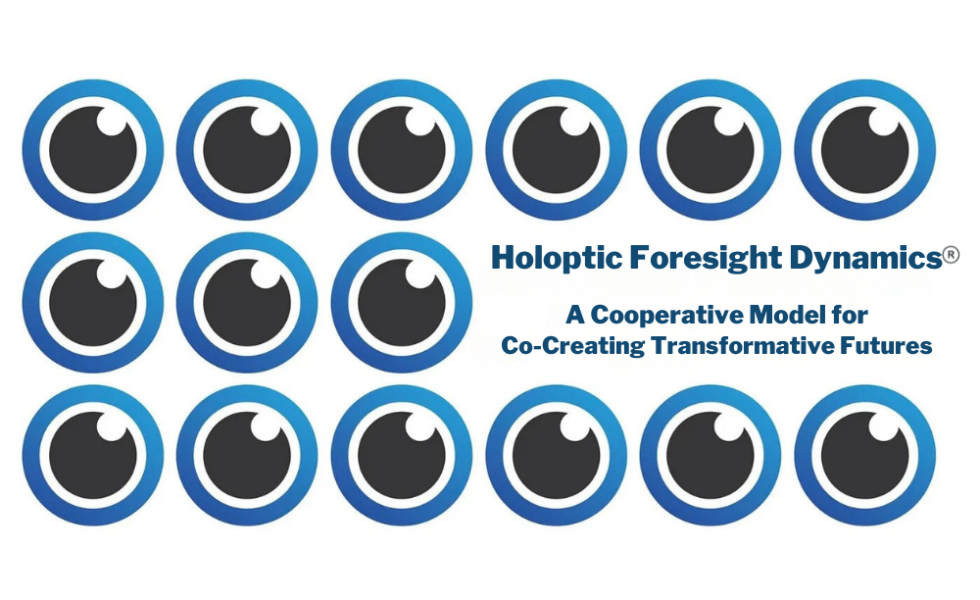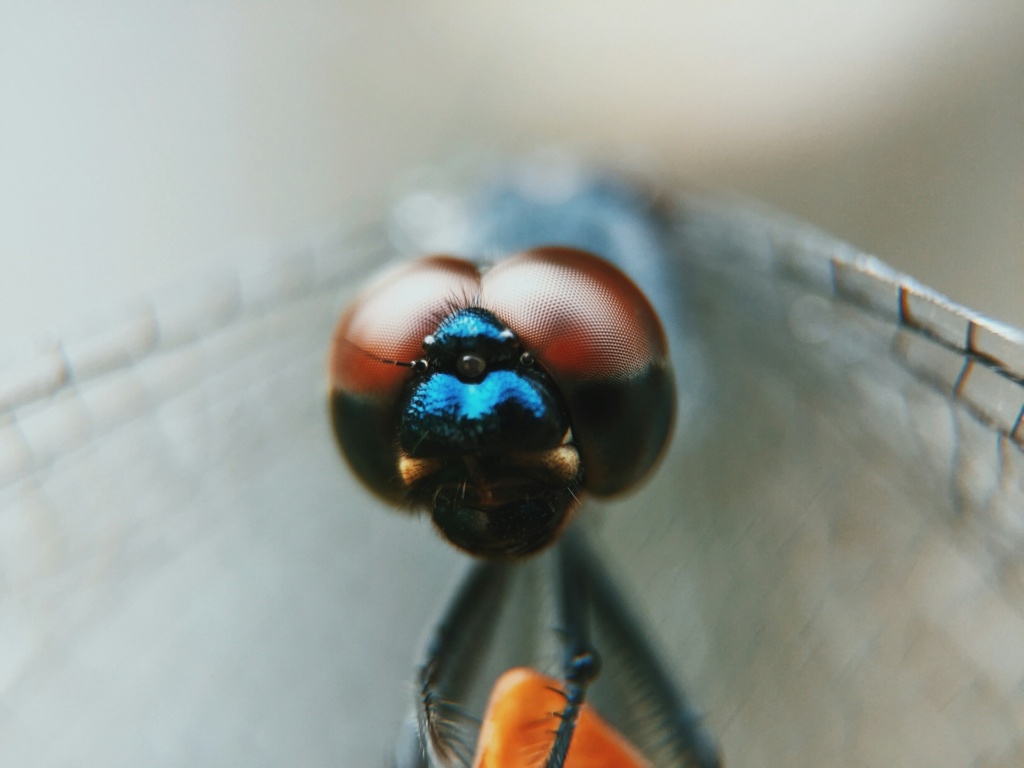Holoptic Foresight Dynamics: The “Many-Eyed” Cooperative Perception of Emergence for Co-Creation of Transformative Futures (Part 1)

It’s no secret that Futures Thinking has been growing in popularity within organizations and governments in recent years, and many of these entities now have foresight practitioners on staff. However, it is often framed within the context of more traditional practices such as strategic planning, trend analysis and research, forecasting, data mining, competitive intelligence and organizational development. Though foresight can certainly apply to and improve those practices — and reshape them to respond to the exponentially changing environment of the 21st century — the field must not fall prey to being defined by them. Rather, foresight opens up a new vista for organizational, governmental and social development, one that can realign our goals and outcomes for greater collective and connective prosperity. In other words, foresight doesn’t just offer us a better skillset; it can foster a better way of thinking and acting that reframes the human experience. So, what exactly does that look like?
In 2009, I spoke at a conference where I introduced a broad-spectrum futures thinking and foresight concept that I had begun developing: Holoptic Foresight Dynamics. HFD (as I will refer to the concept hereafter) is an evolutionary trait model that can help organizations, governments, institutions, and societies to embrace the competency of foresight as a natural and critical part of the human experience. In other words, HFD illuminates the intentional cultivation of foresight as a collective evolutionary trait — and ultimately as a cosmo-centric force — fostering an holistic and anticipatory understanding of emerging realities (as well as transformational and visionary perspectives). I realize that this introductory summary of HFD may be somewhat confusing, so I will break this article into multiple installments to walk through the foundational premises behind HFD, as well as its theoretical and practical applications to organizational, governmental and social manifestations. Some of what I offer in these installments will sound familiar, as HFD is built upon a myriad of ideas from various fields, but the meshing of these concepts and subsequent transdisciplinary outcomes of HFD may seem quite foreign as they relate to traditional organizational studies, scientific management theories, popular temporal/spatial perspectives and present-day social constructs. Nonetheless, this is exactly why I believe HFD to be so exciting and necessary in terms of human development; the thinking and systems that got us to where we are today will not lead us into a more equitable, prosperous and generative future. If we are to step forward as a species into such futures, it must be through mindsets and actions that are collective, cooperative and co-creative.
The foundations of HFD rest on the following statement:
Holoptic Foresight Dynamics®️ posits a change in our cosmological narrative from ‘separate but connected’ to ‘the whole as a unique entity,’ allowing for a greater collective, evolutionary capability to display anticipatory behavior, thereby adaptively and transformatively perceiving and co-creating the emerging future.
The concept of HFD is born out of my interest and work in models such as Causal Layered Analysis (Inayatullah), Spiral Dynamics (Beck, Cowan), Integral Theory (Wilber), Panarchy/Complex Adaptive Systems (Gunderson, Holling), Complex Responsive Processes (Stacey), Regenerative Design (Dias, Wahl, Lanza), Network Theory (Callon, Latour, Law), Appreciative Inquiry (Cooperrider, Srivastva), Action Logics (Torbert), Theory U (Scharmer), Swarm Intelligence (Beni, Wang), Complexity Science/Theory (Wolfram, Hayek), Evolutionary Directionality (Stewart), Warm Data (Bateson), Metamatrix/S-Curve/Natural Growth Curve (Jaccaci, Greiner), Learning Organizations (Senge), and of course, Futures Studies and Strategic Foresight. A broader and connected view of these ideas and models have helped me to see that Foresight — a mindset and practice that I believe to be a critical element in organizational and human development — functions best in an atmosphere where systemic barriers and assumptions are uncovered (as an ongoing process), people are individually and collectively evolving toward a holistic purpose (though diversity at all levels remains intact, and is even fostered as a means to greater creative complexity), and the operating landscape at work is decentralized and accessible by all parties.
Before I further explain the basic idea behind HFD (and its larger connection to a multidisciplinary approach to Futures Thinking and Foresight), let’s explore the meaning of holoptic vision or holopticism.
The term holoptic refers to the compound eye of certain insects such as the dragonfly or some beetles. This holoptic eye covers the entire head of the insect, and allows them to have a “whole-eyed” perspective of their environment — front, back, and side-to-side, all at the same time and within the same field of view. In contrast, large mammals such as humans have “simple eyes” that severely limit our field of view.
The word holoptic is a combination of the Greek words holos (whole, holistic, all), optiké (vision), and tekhné (art, technique). It expresses the capacity for players in a given organization (group, collective, society) to perceive the emerging whole of that organization as if it were a unique entity, be it in a natural physical space or a virtual space. A holoptical space is a space in which each participant gets a live and unfolding perception of the ‘Whole.’ Each player, thanks to his/her experience and expertise, relates to this “Whole” in order to adjust his/her actions and coordinate them with the moves of others (i.e. human and non-human). There is an unceasing round trip, a feedback loop that works like a mirror between the individual level and the collective level. Holopticism — the link between individuals and the whole — provides players with the capacity to operate in a sovereign, independent and diverse manner, but in response to knowing what to do for the sake of the whole and entities within. There is not only horizontal transparency (perception of every other participant in the organization or group), but also a vertical communication with the emerging, unique ‘Whole.’
Another great description of holopticism can be found on the website of the Collective Intelligence Research Institute. They state that,
“We should not confuse holopticism with transparency. Transparency means the capacity to see the actions of everyone. Holopticism applies only when a whole emerges as an autonomous, perceivable entity. For instance the crowd in a bus doesn’t operate as collective unified whole (unless something special happens). 100 players on a sports field won’t make a coherent sports team either, although everyone can see everyone. In both examples, we have transparency, not holopticism. In a holoptical context, the individual knows what to do because he/she gets informed by the whole. Actions don’t need to come from a blind chain of command. Individual and collective actions emerge at crossroads of rules and agreements, player’s roles, individual personalities and styles, the current configuration on the field. Every individual action modifies the whole which in return informs the player about what to do next, and so on. An unceasing feedback loop allows for the individual and the collective to communicate with one another. Holopticism exists as a natural property of original collective intelligence, i.e. small groups that have the capacity to perceive each other and cohere around their actions: clans of evolved mammals (big cats, wolves, elephants, dolphins, whales), some birds (ducks, geese), sports teams, jazz bands, army squad, small villages. Holopticism will become one of the most important issues in future societies who want to harmonize individual and collective freedom. It will become a central question in socialware, communityware and game design (MMOGs).” ( I would add that our governmental structures — particularly democratic representations — must seek out a holoptic evolution. Freedom and diversity of individual players that doesn’t lead to an emerging unique whole that guides the vision and purpose of a democratic society — or any government — results in chaos and breakdown as evidenced in the current trajectory in U.S. governance and society.)
Since there was so much to unpack in the above description, allow me to highlight the most important points:

- Holoptic describes a “whole-eyed” vision that sees the surrounding environment as one unique “whole” entity instead of separate parts.
- This whole-eyed vision creates a simultaneous, constant feedback loop that allows for individual and collective actions to communicate and emerge in a decentralized fashion as resilient, adaptive and transformative needs arise.
- Due to the fact that holoptic vision sees the environment as a unique, autonomous whole entity, it is better suited to perceive and anticipate what is desiring to emerge through the simultaneous actions of the parts and the whole.
- Organizations and entities within holoptic systems are best suited to anticipate and co-create the future in tandem with the complex web of players and organisms that make up the larger biocentric, ecocentric and cosmocentric landscape.
With these explanations in mind, a graphic depiction of an holoptic system might look something like this:
In this representation, we can see that all entities have a line of sight to the other parts of the system or landscape — both horizontally and vertically — and this fosters the creation of a unique whole. Further, the system is open and porous to allow for all responsive processes and potential states to weigh upon the “whole.” This state of operations can produce a much greater degree of success in mapping and actualizing organizational/social/global foresight because it both gifts diverse perspectives toward the whole while simultaneously perceiving the unique whole that is emerging. Though no individual or group can ever predict the future, there is a “place” in social and organizational evolution where the direction and higher order purpose of the “whole” can be perceived, and where those who comprise this unique “whole” can subsequently (and continually) fine tune their own thoughts and actions to participate in the emerging future. We can even say that this relationship is a “co-creation of the future,” a reality that certainly requires us to take up a position of greater humility and cooperation. We may have a hard time imagining such a system being a reality, but this is due to the overwhelming dominance of the concepts and metaphors that have built a monoptic* or panoptic* environment all around us. (i.e. competition, conflict, siloed practices, political barriers, nationalism, intellectual property, “survival of the fittest,” limited resources, scarcity in models of mass consumption, class warfare, etc.)
Now that we have established the idea of holopticism, we will explore how such a perspective and practice is an evolutionary arrow and trait in Part 2 of this article. Ultimately, we will arrive at the larger concept behind HFD — a “whole-eyed” anticipatory perception of complex emergence, and our collective role in co-creating and birthing transformational futures. If we want to remain relevant, this is a transition that we must embrace!
Additionally, in The Dragonfly’s Pact With the Future we dive even deeper into HFD and our biological, evolutionary, and sacred responsibility to the future.

Frank Spencer
Co-Founder
Creative Director
In 2009, Frank founded Kedge – a global foresight, innovation, and strategic design firm which pioneered TFSX. Throughout his career, Frank has worked as a leadership coach and developer with entrepreneurs, social communities, networking initiatives, and SMEs, helping them in areas such as development, innovation, and networking.
Read More
